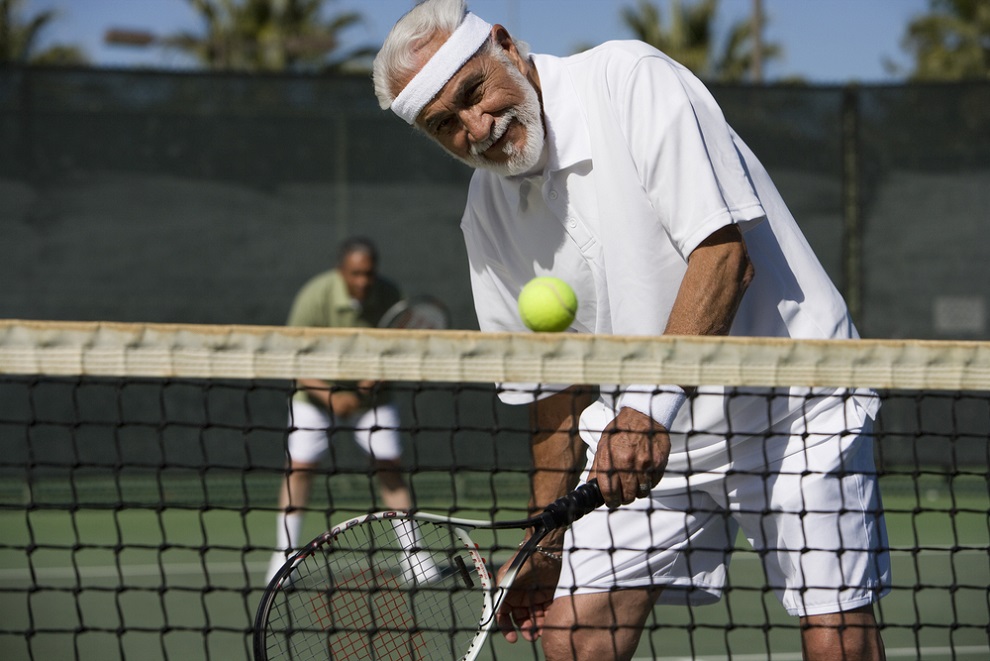Ever wonder why your muscles stay sore longer as you age?
A workout that once left you refreshed now lingers as stiffness and fatigue. It's not just in your head - muscle recovery slows with age. This happens due to changes in muscle composition, hormone levels, inflammation, and overall cell regeneration.
Muscle recovery is a critical part of fitness, injury prevention, and long-term health. Whether you're an athlete, a fitness enthusiast, or just someone looking to stay active, understanding why your muscles take longer to heal is key. The good news? You can take steps to speed up recovery, even as you get older.
In this blog, we'll break down why muscle recovery slows with age, the science behind it, and the best ways to improve it. From nutrition and supplements to sleep and workout strategies, we'll cover everything you need to keep your muscles strong and resilient.

The Physiology of Muscle Recovery
Muscle recovery is a coordinated biological process that allows the body to heal and rebuild after physical exertion.
Whether you're lifting weights, running, or doing any form of exercise, your muscles experience microscopic damage. This triggers a cascade of events designed to repair, strengthen, and prepare them for future activity. Several key physiological mechanisms contribute to muscle recovery.
These processes determine how quickly the body can repair and grow new muscle fibers, reducing delayed-onset muscle soreness and improving overall performance. Below are the main factors that influence recovery and how they work.
Muscle Protein Synthesis (MPS)
Muscle protein synthesis (MPS) is the foundation of muscle recovery. When you exercise, especially during resistance training, muscle fibers undergo tiny tears.
This process repairs these fibers, making them stronger and more resilient over time. Protein plays a crucial role in this process. When you consume protein-rich foods or supplements, your body breaks them down into amino acids. These amino acids act as building blocks for healthy muscle tissue. However, as you age, MPS efficiency declines. This means your body is slower at rebuilding and repairing damaged muscle fibers.
Inflammatory Response
Inflammation is often seen as a negative aspect, but it plays a vital role in muscle recovery. After a workout, the body triggers an inflammatory response to help repair damaged muscle fibers.
This response increases blood flow to the affected area, delivering oxygen and nutrients essential for healing. However, chronic inflammation can slow down recovery and contribute to muscle loss. As you age, your body's ability to regulate inflammation weakens, leading to prolonged soreness and stiffness. This is one of the key reasons why muscle recovery takes longer with age.
Hormonal Regulation
Hormones are chemical messengers that play a significant role in muscle recovery. Two of the most important ones are testosterone and growth hormone (GH).
These anabolic hormones promote protein synthesis, stimulate muscle repair, and help the body recover efficiently. Testosterone, in particular, is responsible for enhancing muscle mass, strength, and recovery. However, testosterone levels naturally decline with age, leading to slower muscle repair and increased fatigue. Growth hormone, which is secreted during deep sleep, also decreases over time, further affecting muscle regeneration.
Male Excel offers hormone replacement therapy (HRT), which can help address declining testosterone levels. Their personalized treatment plans aim to restore hormonal balance, supporting muscle growth and faster recovery.
Satellite Cell Activation
Satellite cells are stem cells located around muscle fibers. They play a crucial role in muscle repair, growth, and adaptation to exercise.
When muscle fibers experience stress or damage, satellite cells become activated and fuse with existing muscle cells to promote healing and increase muscle mass. As we age, satellite cell activity declines. This means muscles take longer to repair themselves, and the body struggles to maintain muscle mass.
Studies suggest that this decline contributes to sarcopenia (age-related muscle loss) and makes it harder for older individuals to recover from physical exertion.
Aging and Its Impact on Muscle Recovery
As we age, our bodies undergo several physiological changes that slow down muscle recovery. Workouts that once left us feeling energized may now result in prolonged soreness, fatigue, and stiffness.
The primary reason is a combination of muscle degeneration, hormonal shifts, inflammation, and neuromuscular decline. Understanding these age-related changes is essential for maintaining muscle health and optimizing recovery. Let's break down the key factors that contribute to slower muscle recovery as we age and how they affect our ability to heal and rebuild.
Sarcopenia - The Loss of Muscle Mass and Strength
Sarcopenia is the gradual loss of muscle mass, strength, and function that occurs with aging. It typically begins around the age of 30 but becomes more noticeable after 50.
This decline is a major contributor to slower muscle recovery, as fewer muscle fibers mean reduced repair capacity. Sarcopenia happens due to a combination of factors, including decreased physical activity, poor nutrition, hormonal changes, and a natural decline in muscle protein synthesis. As muscle fibers shrink and weaken, they take longer to recover from exercise, making it harder to rebuild strength after workouts.
Reduced Hormone Levels Lead to Slower Recovery at the Cellular Level
Anabolic hormones like testosterone, growth hormone (GH), and insulin-like growth factor 1 (IGF-1) are vital for muscle repair and growth.
These hormones stimulate protein synthesis, support muscle fiber regeneration, and enhance recovery efficiency. However, with age, their levels naturally decline, leading to slower healing, increased muscle loss, and prolonged muscle soreness. Testosterone, in particular, plays a crucial role in maintaining muscle mass.
Men experience a 1% drop in testosterone levels per year after 30, while women see a more gradual decline. Low testosterone can result in reduced muscle-building potential and longer muscle recovery time by age. Similarly, GH secretion decreases with age, which affects collagen production, tissue repair, and muscle recovery.
Diminished Satellite Cell Function Leads to Weakened Muscle Regeneration
Satellite cells are muscle stem cells that play a pivotal role in repairing and regenerating damaged muscle fibers.
When a muscle is stressed during exercise, satellite cells activate, fuse with existing muscle fibers, and stimulate growth. As we age, satellite cell activity declines, leading to slower repair and weaker muscle growth. One of the primary reasons for this is fewer muscle fiber activation.
As neural pathways weaken with age, muscles are not stimulated as effectively, causing satellite cells to become less responsive. Additionally, chronic inflammation and oxidative stress further impair satellite cell function.
Increased Inflammatory Response Leads to Prolonged Muscle Soreness and Tissue Breakdown
Inflammation is the body's natural response to muscle stress and injury. After exercise, a temporary inflammatory phase helps clear out damaged cells and initiate healing.
However, in older adults, this inflammatory response becomes prolonged and severe, leading to delayed recovery, increased muscle stiffness, and greater susceptibility to injuries. Chronic inflammation is linked to higher levels of pro-inflammatory markers like C-reactive protein (CRP) and interleukin-6 (IL-6). This type of low-grade, systemic inflammation, often called inflammaging, interferes with muscle repair and accelerates muscle loss.
Neuromuscular Changes: Impaired Coordination and Slower Recovery
Aging affects how nerves and muscles communicate, leading to reduced coordination, slower muscle recovery times, and weaker muscle contractions.
This neuromuscular decline impacts muscle activation and recovery, making it harder for aging individuals to rebuild strength after exercise. One of the key factors behind this decline is motor unit loss. Motor units consist of a nerve and the muscle fibers it controls.
As we age, motor neurons degenerate, leading to fewer active motor units and reduced muscle function. This contributes to slower muscle recovery, impaired balance, and increased risk of falls and injuries.

Strategies to Enhance Muscle Recovery in Older Adults
While aging slows down muscle recovery, adopting the right strategies can help mitigate these effects.
A proactive approach to exercise, nutrition, and lifestyle habits can significantly improve muscle repair, reduce muscle soreness, and maintain overall strength. Below are the top strategies that older adults can use to enhance muscle recovery.
Perform Regular Resistance Training to Counteract Muscle Loss
Resistance training is one of the most effective ways to combat age-related muscle loss (sarcopenia) and improve recovery.
Strength exercises stimulate muscle protein synthesis (MPS), enhance satellite cell activity, and boost anabolic hormone levels, all of which are crucial for muscle repair. Evidence shows that even older adults who have never lifted weights before can experience significant improvements in muscle mass and strength with consistent training.
Exercises such as weightlifting, bodyweight movements (push-ups, squats), and resistance band workouts are excellent options. To improve recovery, it's important to:
- Train consistently (at least 2-3 times per week).
- Focus on compound movements (squats, deadlifts, rows) to engage multiple muscle groups.
- Prioritize progressive overload, gradually increasing resistance over time.
- Incorporate recovery days to allow muscles to repair and grow.
Combining resistance training with proper post-workout nutrition ensures the body has the building blocks it needs for muscle regeneration.
Ensure Protein Intake for Optimal Muscle Repair
Protein is the foundation of muscle recovery. As people age, the body becomes less efficient at using protein to stimulate muscle growth.
This means older adults require higher protein intake compared to younger individuals to maintain and repair muscle tissue effectively. It is recommended that older adults who engage in physical activity consume 1.2-2.0 grams of protein per kilogram of body weight per day.
Some of the best protein sources include:
- Lean meats (chicken, turkey, beef)
- Fish (salmon, tuna, cod)
- Eggs
- Dairy products (Greek yogurt, cottage cheese)
- Plant-based sources (lentils, quinoa, tofu, nuts)
To further boost muscle recovery, protein intake should be evenly distributed throughout the day rather than consumed in one large meal. Adding a protein shake or high-protein snack post-workout can speed up recovery by providing muscles with the necessary amino acids for repair.
Take Omega-3 Fatty Acids to Reduce Inflammation
Omega-3 fatty acids, commonly found in fish oil, flaxseeds, walnuts, and chia seeds, play a crucial role in muscle recovery. Omega-3 supplementation helps:
- Reduce muscle inflammation and muscle soreness after exercise.
- Enhance muscle protein synthesis in older adults.
- Support joint health, reducing stiffness and discomfort.
Pairing omega-3s with vitamin D has been shown to improve muscle repair and function. Since many older adults are deficient in vitamin D, adding foods like fatty fish, fortified dairy products, and egg yolks can be beneficial. Supplements can also be necessary if dietary intake is insufficient.
Consider Hormonal Support for Better Recovery
Aging leads to a natural decline in testosterone, growth hormone, and IGF-1, all of which are important for muscle repair.
While some older adults consider hormone replacement therapy (HRT), this approach comes with potential risks, including cardiovascular issues and hormonal imbalances. Instead of medical interventions, natural methods to support hormone levels include:
- Strength training and high-intensity exercise to naturally boost testosterone and growth hormone.
- Consuming healthy fats (avocados, nuts, olive oil) to support hormone production.
- Managing stress through relaxation techniques like deep breathing and meditation, as stress increases cortisol, which can break down muscle tissue.
Consulting with a healthcare provider is essential before considering any hormone-related treatments. Male Excel specializes in testosterone replacement therapy (TRT) and hormone optimization. Their telemedicine services allow men to receive expert advice from the comfort of their home.
Get Adequate Sleep for Muscle Regeneration
Sleep is one of the most underrated factors in muscle recovery. During deep sleep, the body releases growth hormone, repairs muscle tissue, and restores energy levels.
However, aging often disrupts sleep quality, leading to slower recovery and increased fatigue. To improve sleep and muscle recovery:
- Stick to a consistent sleep schedule, aiming for 7-9 hours per night.
- Avoid screens before bed, as blue light disrupts melatonin production.
- Create a relaxing bedtime routine, such as stretching or reading.
- Limit caffeine and alcohol intake, especially in the evening.
Quality sleep enhances hormonal balance, reduces inflammation, and accelerates muscle repair, making it an essential part of any recovery strategy.
Maintain Hydration to Support Nutrient Transport and Waste Removal
Proper hydration plays a key role in muscle recovery, yet many older adults do not drink enough water. Dehydration slows down nutrient transport, increases muscle cramps, and prolongs muscle soreness.
Key hydration tips for muscle recovery include:
- Drinking at least 8-10 glasses of water daily.
- Consuming electrolyte-rich fluids (coconut water, electrolyte drinks) after exercise.
- Eating water-rich foods like cucumbers, oranges, and watermelon.
Hydration is especially important post-workout, as muscles need fluids to transport nutrients and flush out waste products like lactic acid.
Consume Anti-Inflammatory Diet to Speed Up Recovery
A diet rich in anti-inflammatory foods helps reduce chronic inflammation, support muscle repair, and improve overall recovery. Some of the best anti-inflammatory foods include:
- Berries (blueberries, strawberries)
- Turmeric and ginger
- Dark leafy greens (spinach, kale)
- Nuts and seeds (almonds, walnuts, chia seeds)
Avoiding processed foods, sugary snacks, and excessive alcohol further minimizes inflammation, keeping muscles in an optimal state for repair.
Ensure Regular Physical Activity to Maintain Muscle Function
Regular physical activity, even on non-training days, prevents stiffness, improves blood circulation, and keeps muscles active. Activities such as:
- Yoga and Tai Chi: Improve balance, flexibility, and muscle relaxation.
- Walking: Enhances circulation and prevents muscle stiffness.
- Stretching: Reduces tightness and maintains mobility.
Low-impact movements help prevent injuries while keeping the neuromuscular system engaged, leading to better recovery and long-term muscle health.
Practice Balance and Flexibility Exercises to Prevent Injuries
Aging affects coordination and flexibility, increasing the risk of falls, strains, and muscle injuries. Incorporating balance and flexibility exercises into a routine enhances muscle control and joint stability.
Consider exercises like:
- Balance drills (standing on one leg, heel-to-toe walking)
- Dynamic stretching before workouts to prepare muscles
- Static stretching post-workout to improve flexibility
Performing these exercises daily or at least three times a week significantly reduces the risk of muscle strain and supports faster recovery.
Consult Healthcare Professionals for Personalized Advice
Everyone has unique muscle recovery needs based on age, activity level, and medical history.
Consulting a sports medicine specialist, physiotherapist, or nutritionist can provide personalized recovery strategies, ensuring that training and nutrition plans are safe and effective. Before starting new supplements, hormone treatments, or exercise programs, seeking medical guidance prevents potential risks and helps develop the best recovery plan.
Conclusion
Aging slows muscle recovery but doesn't have to hold you back. By making smart lifestyle changes, you can maintain muscle health and stay active for years to come.
Regular resistance training, proper nutrition, and adequate sleep play key roles in keeping recovery time short. Supplements like omega-3s and anti-inflammatory foods can also help. The key is consistency. Small, daily habits add up to long-term results. Listen to your body, adjust your workouts, and fuel your muscles properly.
Recovery isn't just about bouncing back from workouts; it's about building strength for a healthier future. If you suspect hormonal imbalances are slowing your recovery, consult Male Excel for personalized solutions to optimize your muscle health and performance.

Get TRT Online
Optimize Your Hormones





